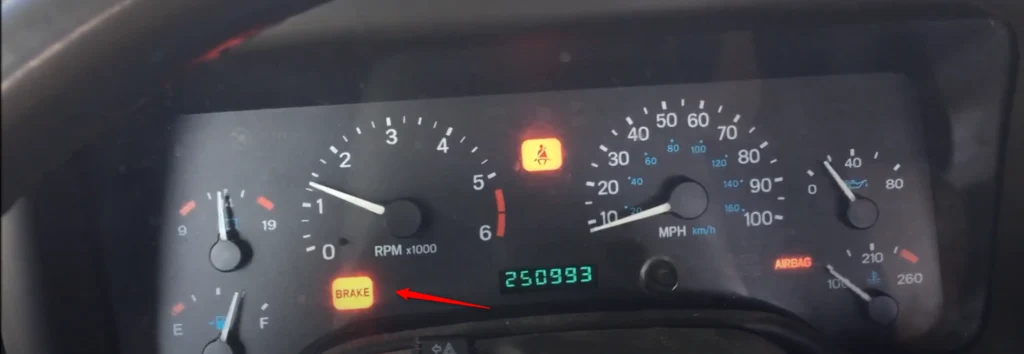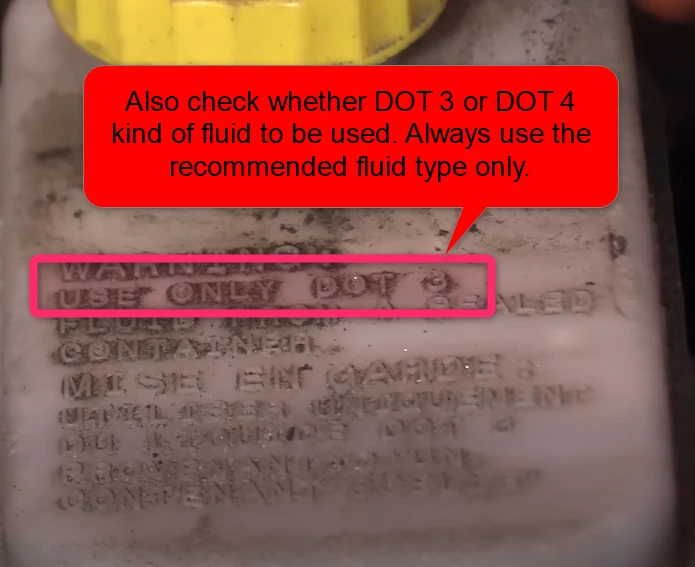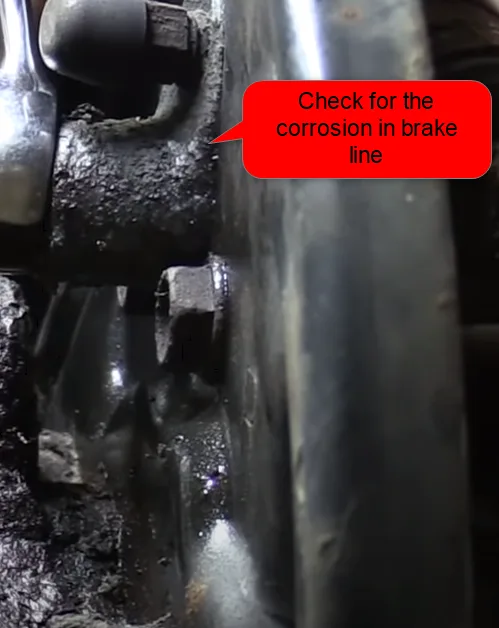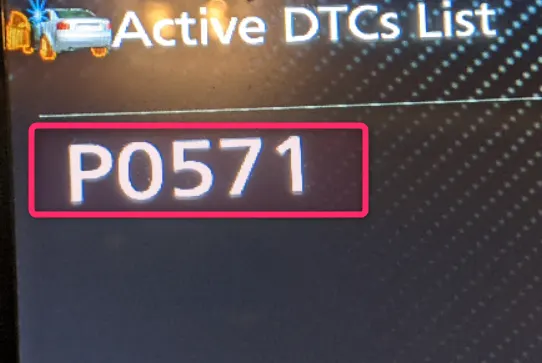Driving a Jeep Wrangler is always an adventure, but it can quickly turn into a nightmare if you notice the brake light flashing. It’s a warning sign that something isn’t right with your braking system, and ignoring it can put you and other drivers at risk. So, it’s essential to address the situation promptly.
The Jeep Wrangler’s flashing brake light is often caused by low fluid, worn pads, faulty brake components, corrosion, ABS sensor issues, or damaged wiring. Addressing these factors promptly ensures optimal brake performance and vehicle safety.
In this article, I’ll explore what the flashing brake light means and what steps you can take to fix the issue. So, if you’re looking for answers, keep reading.
Function and Purpose of The Brake Warning Light in the Jeep Wrangler:
The brake warning light in your Jeep Wrangler is a critical indicator of potential issues within the brake system. It is designed to monitor the hydraulic pressure in the brake lines and alert you to any abnormalities or malfunctions.

When you start your vehicle, the brake warning light, along with other dashboard lights, should illuminate briefly as part of the self-diagnostic system. However, it should quickly turn off under normal conditions, indicating that the brake system is functioning properly.
The primary purpose of the brake warning light is to notify you of any problems with your braking system that require immediate attention. It acts as an early warning system, allowing you to address potential issues before they escalate and compromise your safety.
Here’s why taking immediate action is of utmost importance:
- Safety: The brake system is critical for your safety, and any malfunction can significantly impact your ability to stop or slow down the vehicle effectively. Promptly addressing brake warning light issues ensures your brakes’ continued reliability and functionality.
- Preventive Maintenance: Timely action can help prevent further damage or costly repairs. Ignoring warning signs may lead to more extensive damage to brake components, requiring more time and money to rectify the problem.
- Peace of Mind: By promptly addressing brake warning light issues, you can drive with peace of mind, knowing that you have taken the necessary steps to maintain your vehicle’s safety and performance.
Why Is the Brake Light Flashing on a Jeep Wrangler?
The brake light on your Jeep Wrangler’s dashboard is a crucial safety feature that warns you of a problem with your vehicle’s braking system. Several reasons could cause the brake light to start flashing.
Here are some of the most common ones:
1. Low Brake Fluid Level:
One of the primary reasons for a flashing brake light is a low brake fluid level. The brake fluid reservoir in your Jeep Wrangler has a designated minimum and maximum level.
The brake light will start flashing if the fluid level drops below the minimum. Low brake fluid levels can be attributed to various factors, including leaks in the brake system or worn brake pads.
How to Fix:
Let me explain the steps you can follow to diagnose and fix the low brake fluid issue:
- STEP 1- Check Brake Fluid Level:
Begin by locating the brake fluid reservoir under the hood in front of the driver’s side. Inspect the fluid level, ensuring it is above the minimum line but below the maximum line. If the level is low, proceed to the next step.
- STEP 2- Add Recommended Brake Fluid:
Add the recommended brake fluid to the reservoir until it reaches the maximum level.
It is essential to use the specific brake fluid type recommended for your Jeep Wrangler model to ensure optimal performance.
- STEP 3- Address Potential Leaks:
Low brake fluid levels can indicate a leak in the brake system. Inspect the master cylinder and its surroundings for any signs of wetness or fluid seepage.
Additionally, check under the vehicle, focusing on the connections between the brake calipers and brake lines, for any visible brake fluid leaks. If leaks are detected, it is crucial to address them promptly to prevent further complications.
- STEP 4- Bleed the Brakes (if necessary):
If the brake fluid level is extremely low or air is suspected to have entered the system, bleeding the brakes may be necessary.
It is recommended to consult the Jeep Wrangler owner’s manual or seek professional assistance to ensure appropriate bleeding procedure.
- STEP 5- Address Underlying Issues:
Remember that low brake fluid levels are often a symptom of an underlying problem. While adding fluid and addressing leaks may temporarily resolve the issue, it is essential to identify and rectify the root cause to prevent future occurrences.

Consult a qualified mechanic or take your Jeep Wrangler to a trusted service center for a comprehensive brake system inspection.
2. Worn Brake Pads:
Brake pads play a critical role in the braking system of your Jeep Wrangler. They are designed to create the necessary friction to slow down and stop your vehicle when the brakes are applied.
Over time, brake pads naturally wear down due to repeated use, and if not replaced on time, they can cause various issues, including triggering the brake warning light.
As brake pads wear down, the brake caliper piston extends further to compensate for the decreasing pad thickness. This extension of the piston results in brake fluid displacement from the master cylinder reservoir into the brake caliper, causing a decrease in the overall brake fluid level.
Consequently, the lowered brake fluid level can trigger the brake warning light to start flashing, indicating a potential issue with the brake system.
How to Fix:
You can follow the steps I explained below to diagnose and resolve this issue:
- STEP 1- Visual Inspection:
Start by visually inspecting your brake pads. Remove the wheels and examine the thickness of the brake pads. If they appear significantly worn or have reached the manufacturer’s recommended minimum thickness, it is necessary to replace them.
When the brake pads on your Jeep Wrangler JK have worn down to a minimum thickness of 1/8 inch, it is crucial to replace them. This thickness is considered the threshold for safe braking performance. While a general guideline suggests replacing brake pads and rotors every 50,000 miles for a Jeep Wrangler JK, it's important to note that this mileage can vary based on various factors.
- STEP 2- Brake Pad Replacement:
To address worn brake pads, you will need to replace them with new ones. Ensure that you select brake pads compatible with your Jeep Wrangler’s model and follow the manufacturer’s guidelines for installation.
- STEP 3- Brake System Inspection:
While replacing the brake pads, it is advisable to conduct a thorough inspection of the brake system. Check the condition of the brake rotors for excessive wear or damage. If necessary, resurfacing or replacement of the rotors might be required.
- STEP 4- Brake Caliper Examination:
While inspecting the brake pads, examine the calipers for any signs of damage or sticking. Sticking calipers can cause uneven pad wear and affect braking performance.
If issues are identified, it is recommended to address them promptly by repairing or replacing the affected calipers.
3. Faulty Brake System Components:
The brake system is a complex arrangement of various parts that work together to ensure safe and efficient braking. If any of these components experience issues or malfunctions, it can trigger the brake warning light.
3.1. Faulty Brake Fluid Level Sensor:
One possible faulty component is the brake fluid level sensor. This sensor monitors the level of brake fluid in the reservoir.
If the sensor fails or malfunctions, the brake warning system may send incorrect signals, causing the light to flash. In such cases, it is necessary to replace the faulty sensor to restore the proper functioning of the brake warning system.
3.2. Defective Brake Master Cylinder:
Another potential culprit is a defective brake master cylinder. The master cylinder is responsible for generating hydraulic pressure in the brake system.
If the cylinder develops internal leaks or fails to maintain the required pressure, it can trigger the brake warning light. Repairing or replacing the master cylinder may be necessary to resolve this issue.
3.3. Faulty Brake Calipers or Wheel Cylinders:
Faulty brake calipers or wheel cylinders can also lead to a flashing brake warning light. These components apply pressure to the brake pads or shoes, resulting in the desired braking action.
If the calipers or cylinders malfunction or seize, it can affect the braking performance and activate the warning light. Replacement or repair of the affected components is crucial to address this problem.
How to Fix:
If the brake fluid level and brake pads are fine, the issue may lie with a faulty brake system component. It’s best to take your Jeep Wrangler to a certified mechanic who can fix the problem.
4. Corrosion:
When corrosion affects the brake light switch in your Wrangler, it can lead to a malfunction and the flashing of the brake warning light. Corrosion occurs due to exposure to moisture, road salt, and other environmental factors that can cause the switch to deteriorate over time.
How to Fix:
To address this issue, you can take the following steps as I put down below:
- STEP 1- Inspect the brake light switch:
Locate the brake light switch, usually located near the brake pedal assembly.
Carefully examine it for any signs of corrosion, such as rust or greenish deposits. Corrosion can interfere with the proper functioning of the switch.

- STEP 2- Clean the switch:
If you notice corrosion on the brake light switch, clean it thoroughly using an appropriate electrical contact cleaner.
Disconnect the switch and apply the cleaner to remove any corrosion or debris. Use a soft brush or cloth to scrub the affected areas gently.
- STEP 3- Check wiring connections:
While inspecting the switch, also check the wiring connections associated with it. Ensure that the connections are secure and free from corrosion. If you find any loose or corroded connections, clean them and tighten them properly.
- STEP 4- Replace the switch if necessary:
If the corrosion has caused irreparable damage to the brake light switch or if cleaning does not resolve the issue, it may be necessary to replace the switch.
Consult your vehicle’s manual or seek the assistance of a qualified mechanic to ensure you select and install the correct replacement switch.
- STEP 5- Prevent future corrosion:
Consider applying a corrosion-resistant coating or grease to the switch and surrounding components to prevent future corrosion. This can protect against moisture and environmental factors that contribute to corrosion.
5. Presence of Bad Wheel Speed Sensor:
When the brake light on your Jeep Wrangler starts flashing, one possible cause could be an issue with the ABS sensor, also known as the wheel speed sensor. The ABS plays a critical role in regulating brake pressure and preventing wheel lock-up during braking.
The wheel speed sensors are responsible for monitoring the rotational speed of each wheel and providing this information to the ABS control module.
If there is a problem with the ABS sensor, it can lead to the brake light flashing on your dashboard. Here are some potential issues that can arise with the ABS sensor:
5.1. Sensor Malfunction:
Over time, the ABS sensor may become worn or damaged, leading to inaccurate readings or complete failure. This can result in the brake light flashing as the ABS detects a problem with the sensor’s data.
5.2. Sensor Contamination:
The wheel speed sensors are exposed to various elements, such as dirt, debris, and road grime. If these substances accumulate on the sensor’s surface, it can interfere with its ability to detect wheel speed accurately. As a result, the brake light may start flashing.
5.3. Wiring or Connector Problems:
Wiring and connectors connect The ABS sensor to the vehicle’s electrical system.
A loose connection, damaged wiring, or a faulty connector can disrupt the communication between the sensor and the ABS control module. This can trigger the brake light to flash as the system detects an issue with the sensor’s signal.
How to Fix:
A thorough inspection is necessary to identify problems with the ABS sensor in your Jeep Wrangler. One of the most effective methods for diagnosing ABS sensor issues is connecting an OBD-II scanner to your vehicle and reading the error codes it retrieves.
Code P0571 indicates a brake switch ‘A’ circuit malfunction in your Jeep Wrangler.

By accessing the onboard diagnostic system through the OBD-II scanner, you can retrieve specific error codes related to the ABS.
These error codes provide valuable information about your vehicle’s affected sensor or circuit. They help pinpoint the exact cause of the flashing brake light.
My Recommendation:
The OBDLink MX+ OBD2 Bluetooth Scanner is a powerful wireless adapter that transforms Android, iPhone, or Windows into a professional-grade diagnostic scan tool.
With this scanner, you can access manufacturer-specific vehicle data, monitor real-time performance, and even use it as a trip computer. It's the ultimate tool for car enthusiasts and professionals alike.
This scanner is recommended for use with popular diagnostic apps like Dashcommand, Carista, Torque, FORScan, BimmerCode, AlfaOBD, and many more.
With the OBDLink MX+, you can clear the Check Engine Light and access more live parameters than any other scanner on the market.
Key features:
- Clear Check Engine Light and access more live parameters than any other scanner.
- Over-voltage and battery drain protection for safe and worry-free use.
- Firmware updates to keep your scanner up to date with the latest features.
- Hacker-proof wireless security to protect against unauthorized access.
- Reliable and rock-solid connection with no dropped packets or gaps in the data.
6. Damaged Sensor Wire or Connector:
It has been observed in the Jeep Wrangler that sometimes the sensor works properly but still shows interrupted signals due to damaged connectors or wirings.
How to Fix:
You can inspect the wiring and connectors of the affected sensor area. Look out for any damage or corrosion signs on these components and seek mechanical assistance to replace them with a new set of wires and connectors.
DIY Brake Light Fixes:
As a responsible vehicle owner, it’s essential to have some basic knowledge of maintaining and troubleshooting your brake system. While complex issues are best left to professionals, there are a few DIY brake light fixes you can perform yourself.
Let me explore 3 standard DIY techniques:
- Bleeding the brake system
- Replacing worn brake pads
- Troubleshooting common issues
Bleeding the Brake System:
Bleeding the brake system is necessary when air bubbles or contaminants have entered the brake fluid, compromising its effectiveness.
To bleed the system, follow these steps:
- STEP 1- Gather the necessary tools: You’ll need a wrench, a clear tube, a container to accumulate the old brake fluid, and fresh brake fluid of the recommended type for your vehicle.
- STEP 2- Locate the brake bleeding valves: On each brake caliper or wheel cylinder, you’ll find a brake bleeding valve. These are usually small screws or bolts.
- STEP 3- Start with the furthest wheel: Begin with the wheel farthest from the brake master cylinder. Loosen the bleeding valve using the wrench and attach the clear tube. Place the other end of the tube into the container to collect the old brake fluid.
- STEP 4- Have a helper assist you: Ask a helper to press the brake pedal gradually and keep it down while you unlock the bleeding valve. This will force the old fluid and air bubbles out through the tube. Close the valve before your helper releases the pedal.
- STEP 5- Repeat the process: Repeat the process for individual wheels, moving from the farthest to the nearest. Remember to periodically check and top up the brake fluid reservoir during the process.
Replacing Worn Brake Pads:
Worn brake pads can affect your vehicle’s braking performance and trigger the brake warning light.
To replace them, follow the steps below:
- STEP 1- Gather the necessary tools: You’ll need a lug wrench, a C-clamp or brake piston tool, a wrench or socket set, and new brake pads that match your vehicle’s specifications.
- STEP 2- Lift the vehicle and remove the wheel: Use the lug wrench to loosen the wheel nuts, lift the Jeep securely, and remove the wheel.
- STEP 3- Remove the old brake pads: Locate the brake caliper held in place by bolts or pins. Remove these fasteners to access the brake pads. Carefully take out the worn brake pads.
- STEP 4- Install the new brake pads: Place the new brake pads into the caliper, ensuring they are positioned correctly. Reinstall any pins or bolts that secure the caliper.
- STEP 5- Compress the brake caliper piston: If the caliper piston is extended, use a C-clamp or brake piston tool to compress it. This will create space for the new, thicker brake pads.
- STEP 6- Repeat the process for other wheels: Repeat the above steps for the remaining wheels, one at a time.
Troubleshooting Common Issues:
Sometimes, the brake light may flash due to common issues that can be easily addressed.
Here are a few troubleshooting steps you can take:
- STEP 1- Check the brake fluid level: Ensure the brake fluid reservoir is filled to the recommended level. If it’s low, top it up with the appropriate brake fluid.
- STEP 2- Inspect for leaks: Look for any signs of brake fluid leaks around the brake calipers, wheel cylinders, or brake lines. If you find a leak, have it repaired promptly.
- STEP 3- Clean or replace brake light switch: The brake light switch near the brake pedal can accumulate dirt or become faulty. Clean it with a contact cleaner or replace it if necessary.
- STEP 4- Check the brake pedal position: Ensure the brake pedal is fully releasing and not sticking. A stuck pedal can cause the brake light to stay on.
Symptoms Indicating Brake Damage in the Jeep Wrangler:
Here we will discuss some significant symptoms which indicate damage to the brake light in the vehicle due to which it flashes in it:
Symptoms | Description |
Presence of squeaking noise |
|
Production of grinding noise |
|
Vibrations during braking |
|
Presence of spongy brakes |
|
Pulling of the Jeep due to poor brakes |
|
Presence of burning smell in vehicle |
|
How Can You Turn Off the Flashing Light in Your Jeep Wrangler?
To turn off the flashing brake light in your Jeep Wrangler, you need to restore the braking line pressure in both brake circuits. The most effective way to do this is by pressing the brake pedal.
The braking system is activated by applying pressure to the pedal, allowing the hydraulic pressure to build up and restore the line pressure.
Is It Safe to Drive When Brake Light Illuminates?
Driving your vehicle when the brake light illuminates is not recommended, as it can be unsafe and potentially lead to loss of control.
When the brake light is illuminated, it indicates a potential issue with the braking system that requires immediate attention. It is essential to prioritize your safety and the safety of others on the road by taking the necessary steps to address the problem.
- Continue driving the Jeep towards the repair shop and get the braking fluid and other components like sensors and spark plugs inspected thoroughly by them. Repair or replace these components at your ease.
- If you face hard braking while driving your vehicle and the braking light flashes, it is better to pull the vehicle to the side of the road and seek assistance from the breakdown service.
- Check the fluid levels in the brake, top up the gas tank to its maximum extent, and then check the working of the brakes. If the brakes are in normal condition, but still the warning lights are on, it is better to seek help from a repair shop that can examine the issue.
Remember that even if the brakes seem to be working normally despite the illuminated brake light, it is still essential to have the problem diagnosed and fixed by a professional.
The brake warning light is a crucial safety indicator, and ignoring it or attempting to continue driving without addressing the underlying issue can lead to potentially dangerous situations.
Final Thought:
Understanding the reasons behind a flashing brake light in your Jeep Wrangler is essential for maintaining the safety and functionality of your vehicle’s braking system.
You can promptly address potential issues by understanding and diagnosing the problems in the brake warning light and taking immediate action when it illuminates.
Remember, when in doubt, it is advisable to seek professional help to ensure the integrity and reliability of your vehicle’s braking system.
Also Read:
10 Common Jeep Liberty Diesel Engine Problems- How to Fix
8 Reasons Jeep Radio Not Working- How to Fix
How to Upgrade Performance on 3.8 Jeep JK? Recommended Gears
Top 8 Reasons Your Jeep is Making Ticking Noise- How to Fix
Why is Jeep Overheating? Easy Fixes You Need to Know
Frequently Asked Questions (FAQs):
Is the Jeep Wrangler engine considered a reliable option?
The Jeep Wrangler engine is considered reliable if you ignore its significant flaws. It has good oil sealing, and the head gasket is designed well. The design has fundamental flaws, including issues with the spark system and fuel.
What are some issues with the Jeep engine of Wrangler-liter?
It has been reported by the owners that Wrangler-liter engines consume about a quart of oil every 1000 miles. This excess oil consumption makes the engine inefficient to work, becoming an expensive ride for the common man. Sometimes, the oil indicator system does not indicate low oil levels, which can be dangerous.
How many miles can a Jeep Wrangler engine last?
The Jeep Wrangler engine can average for about 130,000 to about 200,000 miles. This vehicle can cover these miles if the oil changes after a specific interval and the vehicle is maintained.
Is there any timing belt for Jeep Wrangler?
Yes, a recommended timing belt replacement is used in the Wrangler engine of vehicles covering 120,000 miles.
Are 4-cylinder turbo vehicles considered fast ones?
Four-cylinder turbo vehicles are considered the fast ones and offer top performance to their users. The vehicles, which are exotic and sport-like, hit top speeds of about 180 mph.

This is Surya. I am an experienced off-roader. I have been off-roading for many years across several terrains. I am passionate about 4×4 driving and want to share my knowledge and experience with others.
My goal is to provide you with the most comprehensive and unbiased information about off-roading.
I curated this article through my personal experience and expertise, and I hope it helps you with what you are looking for.


 (+91)9123743026
(+91)9123743026
 24/1 Nibedita Sarani. M.B. Road, Kolkata- 700051, India
24/1 Nibedita Sarani. M.B. Road, Kolkata- 700051, India